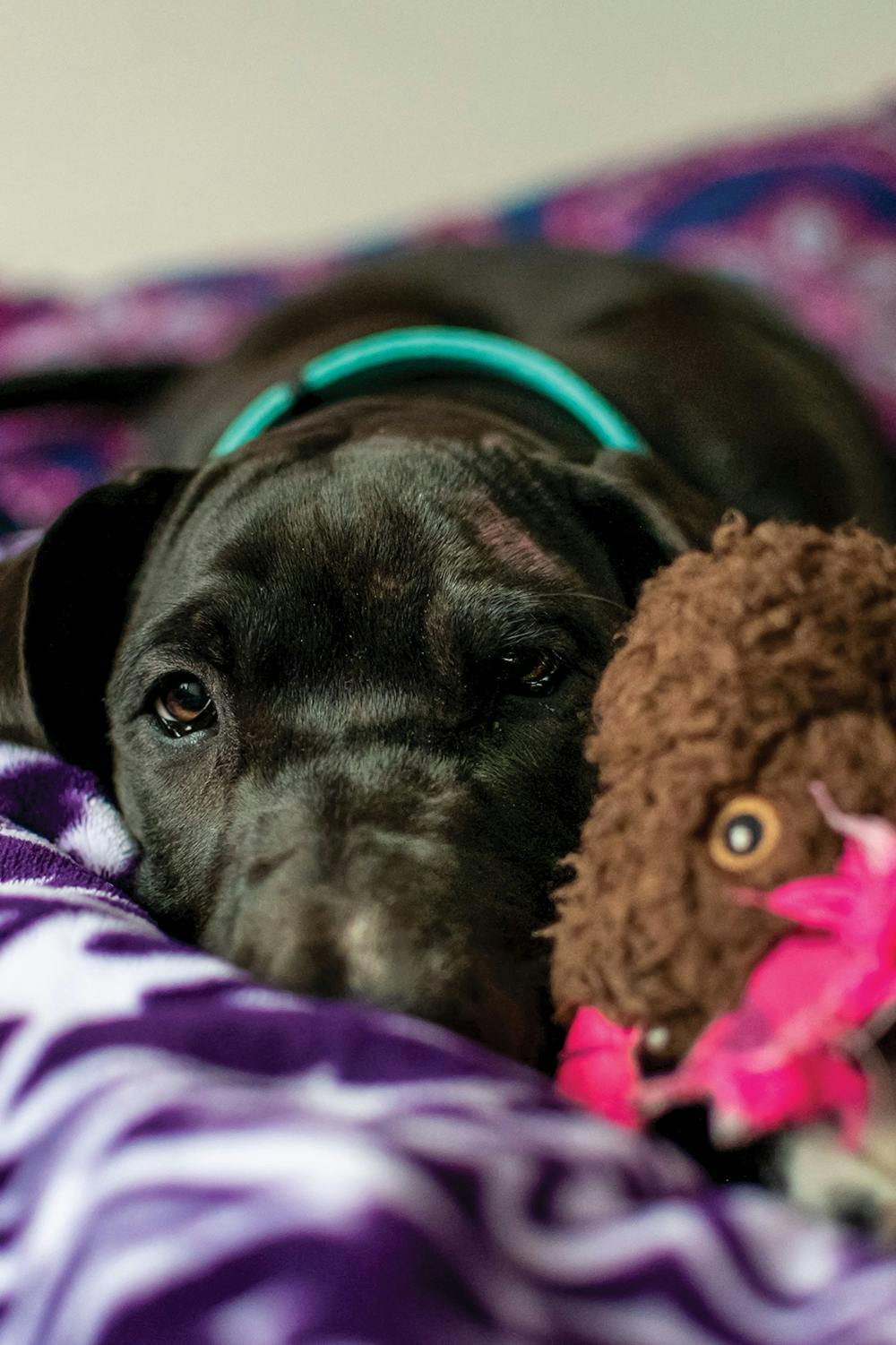Photo by Alyssa Rasp
You’ve asked yourself this question before. At your busiest, maybe, studying for three exams and writing two papers: I wish I could cuddle up to my dog right now. Or a tranquil fall afternoon on the Horseshoe: That student looks so happy walking their dog. How hard could it be? Between Dogs on Davis, the Center for Health and Well-Being’s canine employee, and the recently adopted dogs working in the Honors College, it’s clear that the university endorses a little pet therapy to solve the stresses of college life. But before you believe the hype, the three students (and one veterinarian) below have some advice to pass on. These are people who really love dogs—and part of loving dogs, they know, is questioning whether you can truly give them what they need to thrive.
The following stories are close-to-direct transcriptions, lightly edited for clarity and concision.
Emily
Senior, Sociology
I adopted Cola from a local shelter when he was around 8 months old. He was pretty trained when I got him. He was dog-friendly and people-friendly; we didn’t know about cats, but turns out he likes cats, too. I did enroll him in a training course. I was able to afford it, but some people can’t. He did one at PetSmart, which cost a little over 100 [dollars], which is actually one of the cheaper options.
I was not spontaneous before, but I’ve lost any sense of spontaneity now. If I want to do something, I have to find someone to watch him or make sure Cola can be in his cage that long.
One day, coming home from class, there was blood and poop splattered all over my walls and floors. He had to have emergency bloodwork done. He ended up having an upper GI infection, which cost me over $250.
I purposely plan my classes to be back-to-back and in the middle of the day. I wake up around 6—that way I can feed him, walk him, then play a little bit before he gets in his cage. Saturdays are the hardest because I’m in band, so I’m gone all day long. I usually contact friends to watch him and pay them what I can.
My parents were 100% against me getting this dog, so I’ve been totally on my own.
Every morning, though, Cola wakes me up by laying on top of me and licking all over my face. He’s just a genuinely happy dog. And for me, that’s worth it in the end. He’s a good boy.
Anna
Senior, Public Health
My roommate had a friend whose brother’s roommate found Breezy. In Greenville, he came across this dog getting hit with a stick on the street. Basically, he pulled this weird form of vigilante justice, knocked the guy out with his longboard, and brought her back to his dorm. There was no way Breezy could stay there.
I had really wanted a dog who needed a home, not a random dog. I wanted a mutually beneficial relationship. I remember my roommate and I charting out a schedule in our agendas, then walking to each room in the apartment, asking each roommate, “What if we got a dog?”
In retrospect, we had no idea—it should have taken a lot more consideration. Anyone who is thinking about getting a dog: Have a full week where you sit down at the end of the day and say, "When would I have taken a dog out today? How much time would I have spent with her? Did I have money to get her food?"
But then my roommate and I drove to Greenville two days later. We brought her home for what we said would be a trial period, and what ended up being all of us immediately falling in love with her.
The shift was spring break. I left for a weekend and she stayed out at a friend’s parents’ lakehouse. When I came to get her, she was jumping up and down, so excited to see me, but also started nipping at my shoes and sleeves.
The next morning, we went on a walk to the baseball field in our neighborhood where I let her off the leash to play fetch like we did every morning. She got distracted by these construction workers and I just saw her eyes change. It was this immediate thing. She bit onto my wrist, shaking it around, and as I pulled it away, she ripped my sweater clear off my body.
After that, we’d have to pin her to the ground and loop the leash through her mouth coming home from walks. I was covered in bruises for weeks. It stopped being playful. It was like a mini dog attack every time. I stopped going on walks alone. Someone would have to come with me, which ended up affecting all of my roommates’ sleep schedules.
It didn’t matter how much exercise we got her. For some dogs, that trauma is just so ingrained that there’s just nothing you can do.
Training would have been astronomical—$3000 for the least expensive one geared toward aggressive dogs. Most programs stated on the website: for some dogs, this might not work. Imagine my life savings, some of my parent’s savings, spent on training that didn’t work, and then back to square one. It felt like we were out of options very quickly.
We knew she had puppies. Her ears were clipped, so she was likely a breeder for fight dogs; maybe she even got fought. She was a pit mix, so we can only assume. But she was so sweet. She never acted up in the apartment. I slept in bed with her every night. We’d do little flower crown photoshoots. She was so gentle; she never barked. I don’t know what her bark sounded like. And she liked to sit right on you, climb into your lap and cuddle.
It was so hard to even tell people. We lived through it for weeks, even months, because she was a good dog. That was the root of it. She was a good dog who had trauma. Like, fine, I’m bruised and scared to take her on walks—that’s one part of her. I just can only imagine what she went through.
I think that there is a necessary humility in realizing that you can’t just take any dog. Serious training goes into being able to take care of a dog like Breezy. I was so against the idea of just getting some pretty dog for Instagram that I was like, “I’ll just take a dog who needs me,” but you have to think about what you can give that dog. When I get a dog after college, I won’t go into it with this dog-savior complex, this idea that I can help any dog, no matter what they’ve been through, because that’s not a reality, especially for college students.
Katie
Graduate, Art Studio; Design
I worked at PetsInc, a local privately-owned nonprofit rescue, for two and a half years. Basically what we do is we take in animals, we give them all the medical stuff they might need, and we adopt them back out to the public. I was an adoption counselor for most of my time there.
The students who came in to adopt a dog usually wanted a puppy; if they expressed interest, I had to explain to them that puppies are a ton of work—they poop everywhere, they eat things they shouldn’t, and you have to be able to take them outside every two hours, which I know during my college experience wouldn’t have worked.
PetsInc has a new rule that you need to be over 21 to adopt. Before I started working, a bunch of people had come in and adopted animals throughout the semester and summer. Right as the semester ended, we got dozens of calls saying, “I’m going home to Michigan,” or “I’m moving, I can’t take this dog with me.” That season, we ended up having over 100 animals returned.
They must have thought they were buying a sweater. A dog isn’t something you can just return.
For example, this one senior girl came in and wanted to adopt a puppy. I sat down with her and asked her to tell me about her living situation. What happens if this puppy chews up your rental and you have to pay to get it fixed? What if you land your dream job and it’s out of the country or state? And she was like, I can’t say what would happen. This time for college student is so transitional; it’s hard to keep something as consistent as an animal. There are people who’ve been able to do it successfully, but for most of us, it’s not going to happen.
Make sure you have enough time for your dog, especially at first. The first three weeks of owning an animal is critical. If there’s no one there to make sure (a) it’s not getting into trouble and (b) making sure its settling into its new environment, then it’s going to set you up for failure. Have a lot of patience—no matter what age animal you get, shit’s going to happen.
Dr. Kelsey Callaghan
Griffin Animal Hospital
The financial aspect is always the one thing students are unprepared for. A dog is an incredible, life-long financial responsibility. The puppy series of vaccines includes four exams, vaccines, fecal checks, heart worm and flea prevention. Then you need to get the puppy spayed or neutered and pay for exams, vaccines, and bloodwork every year. Not to mention the potential for unexpected costs, such as intestinal blockages, injuries, sickness like kennel cough from going to the dog park. The list is endless. You can't expect your dog to never need veterinary care and you should have a savings plan in place in case something happens.
[Veterinary] services are undervalued. People are constantly seeking out "cheaper" options. The problem with a cheaper option is when you cut costs you are also cutting the quality of medicine and services provided.
I think that college students really do love their animals and want the best for them, whether they are truly able to provide that for them or not. I think students try their hardest when I ask them to do things at home to help with their pet's care, like soaking a wound a home twice daily. It is usually asking for them to spend extra money they weren't expecting that is the issue (unless they can call mom or dad for help).
Puppies and kittens given as pets are at the highest risk for being returned to a shelter. College students have so much going on with school (and potentially jobs) that a puppy is too much of a responsibility, and possibly a distraction from what is most important. I know it looks like so much fun to have a puppy, but it's not fair to the animal if you are not able to give it to proper attention it needs. There is plenty of time to adopt a fur baby of your own; I recommend waiting until you are more settled before taking that leap. And please: adopt, adopt, adopt!

